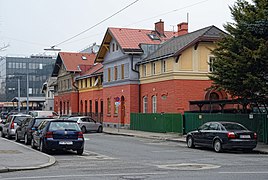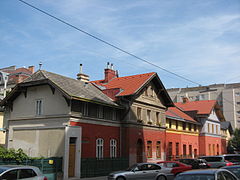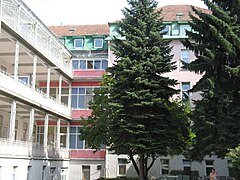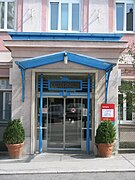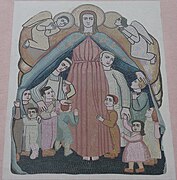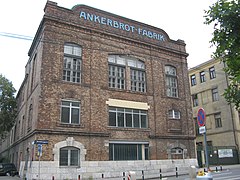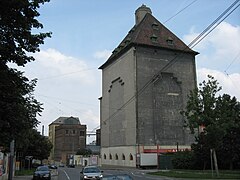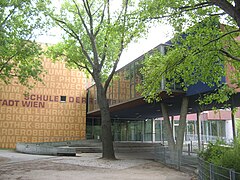Absberggasse
| Absberggasse | |
|---|---|
| Street in Vienna | |
| Basic data | |
| place | Vienna |
| District | Favorites |
| Cross streets | Gudrunstraße , Erlachgasse , Quellenstraße , Buchengasse , Kiesewettergasse, Puchsbaumgasse, Kudlichgasse, Feuchterslebengasse, Ferdinand-Löwe-Straße, Waltenhofengasse, Laaer-Berg-Straße , |
| Buildings | Preyer's Children's Hospital |
| use | |
| User groups | Car traffic , bicycle traffic , pedestrians , tram line 6, bus line 68A |
The Absberggasse is a street in the 10th Vienna district, favorites . It was named in 1875 after the vineyards In den Absbergen , Im upper Absberg and Im lower Absberg , which were historically mentioned in 1690 . The name Absberg is possibly derived from "des Abtes Berg", ie a monastery property.
Course and characteristics
The Absberggasse runs in the far east of the historic Favorit in a north-south direction from Gudrunstraße to the cul- de -sac-like end of the Südosttangente city motorway , which was built on the confluence of the street with Favoritenstraße at Grenzackerstraße (today the favorite distribution circle called Altes Landgut ) . It rises steadily to the south towards the Laaer Berg and is only partially lined with residential buildings. A cycle path runs along the entire length of Absberggasse (50 house numbers).
Tram lines 6 and 11 only use the street between Gudrunstraße and Quellenstraße , otherwise there is no public transport. North of Gudrunstraße, the new southern terminus of tram line D crossing the city was built in 2019, which now runs with the destination Absberggasse.
In the northern area there are residential buildings from around 1900, in the upper half only buildings from the years since 1990.
Notable buildings
Crete
Absberggasse begins on Gudrunstraße on the eastern side with residential buildings from the end of the 19th century, which, together with the apartment buildings on the three eastern parallel streets up to Quellenstraße, are popularly known as Crete and in 2010 were referred to as “one of the poorest and most neglected old building districts in Vienna”. (Renewal plans for the quarter were announced in 2018.) On the opposite, western side of the street are the family pool Gudrunstraße and the Laaer Berg water lift (Quellenstraße 24) with sports fields above.
No. 16–20: Single-family houses for workers
In 1886/87 Josef Unger built single-family houses for workers between Absberggasse, Schrankenberggasse and Puchsbaumgasse (three blocks on the western side of the street) , which are unusual for Vienna and unique in this form. Following English models, small two-story single-family houses with gardens and front gardens were built, which were built along the streets as perimeter structures. They have roof gables and are built in exposed brick, with the upper floors partially plastered. The houses on Absberggasse are particularly well preserved, while the others have since been changed. The ensemble is a listed building .
No. 25: urban housing complex
A large urban residential complex was built in 1982–1985 on the former anchor bread grounds on the opposite side of the street between Absberggasse, Quellenstrasse and Puchsbaumgasse . The architects Friedrich Albrecht, Carl Appel , Helmut Kunze, Herbert Müller-Hartburg, Kurt Neugebauer and Robert Sturmberger were involved in the planning. Here there are 750 apartments along with business premises, common rooms and a daycare center.
No. 32: Preyersches Children's Hospital
On the western side of the street was the area of the Preyer's Children's Hospital , which was fenced in by a wall and has been run as a department of the Kaiser-Franz-Josef Hospital since 2008 . The entrance was in the parallel Schrankenberggasse at no.31. The hospital was demolished and residential buildings were built from 2018, which will be ready for occupancy in 2019.
No. 35: Anchor bread factory
The anchor bread factory is an extensive industrial plant, which in its current form mostly dates from the 1920s. The Viennese bread and pastry factory Heinrich & Fritz Mendl , whose trademark was the anchor, was founded in 1891 and relocated to its current location in 1893. The parts of the factory that were completed in the mid-1920s have been built since 1900. In 1906 the name of the company was changed to Ankerbrot . It became one of the most famous and traditional companies in Vienna. In the 1930s, the well-known advertising slogan emerged: What does the Viennese look forward to when they come back from vacation? On spring water and anchor bread.
The workers at the anchor bread factory have always been very well organized in terms of trade unions. In 1918 they formed around a thousand workers to protect the factory, which made them one of the strongest such organizations in Vienna. During the February fighting in 1934 , this was a base for both the Republican Protection Association and the Social Democratic Party .
After Austria was " annexed " to the German Reich in 1938, the company owned by the Jewish family was "Aryanized" . When the wage tax was raised to the level of the Reich German while the wages remained the same, sensational strikes took place in the anchor bread factory, which were ended by the Gestapo .
Today there is a memorial plaque in the factory that commemorates resistance fighters such as Alexander Scheck , who was shot on February 13, 1934, Käthe Odwody , who was executed in 1940, and Ludwig Führer and Franz Misek , who were executed in 1944. After the war took place because of financial difficulties, the merger with the hammer bread works for the United Food Industrie AG .
Production and workshop buildings, warehouses and loading halls as well as granaries are located on the almost square company site. The old granary (object 14) was built in 1900 by Friedrich Schön. It is a cubic five-story brick building. Next to it is the New Grain Silo from 1926/27, which has a monumental effect with its windowless, towering street fronts. It is a reinforced concrete structure with 30 reinforced concrete silo chambers inside. The large loading hall from 1925, which is over 50 meters wide and made of reinforced concrete, is also of interest.
Because Ankerbrot was in financial difficulties, the large factory had to be transferred to a consortium of five banks in 2003, which in 2009 sold parts of the area to the entrepreneur Walter Asmus. He did not want to demolish the old stock, but instead “began to sell the charm of the old bread factory.” According to his statements, 70% of the lofts had already been sold in the summer of 2010 . Although Ankerbrot had sold the site and the new owners brought two eviction orders, the company continued to produce and invest there and has been planning to buy back the actual production site since 2010. This created conflicts of interest with the buyers of the lofts. In 2011, the intention to keep bakery production on Absberggasse was confirmed by Ankerbrot owner Peter Ostendorf. In 2019 the historic anchor bread factory was sold.
No. 47–51: Monte Laa with Porr high-rise
South of the anchor bread factory and a few gardens stands at the junction with the Laaer-Berg-Straße the high-rise construction group Porr extends 21-storey built in 1999. Behind the 2001 to 2008 built residential and residential Monte Laa - "a prestige project of subsidized Viennese living" - partly above the covered motorway route of the south-east bypass.
Alfred Boehm Park
To the south of Laaer-Berg-Strasse , on the western side of the street, the Alfred-Böhm-Park, named in 1998 after the popular actor Alfred Böhm from Favoriten, extends . In the south, on the Absberggasse side, there are extensive children's areas and playgrounds.
No. 50: Open Middle School
At the end of Absberggasse is the secondary school (today Open Middle School) built between 1991 and 1994 based on plans by Rüdiger Lainer and Gertrud Auer. The school was configured like a comb in order to achieve optimal exposure of the classrooms. At the entrance there are ceramic figures from the in-house ceramic room.
Individual evidence
- ↑ a b c Joseph Gepp: A 3/4 kilometer Vienna , in: Wochenzeitung Falter , Vienna, No. 34, August 25, 2010, p. 31 f.
- ↑ Verena Kainrath: Anker wants to stay in Vienna and buy back bread factory , in: Daily newspaper Der Standard , Vienna, August 11, 2011, p. 17.
- ↑ Anchor bread moves to Simmering. wien.orf.at, June 13, 2019, accessed on June 13, 2019 .
literature
- Herbert Tschulk: Viennese district culture guide favorites . Jugend & Volk, Vienna 1985, ISBN 3-224-16255-4
- Felix Czeike (ed.): Absberggasse. In: Historisches Lexikon Wien . Volume 1, Kremayr & Scheriau, Vienna 1992, ISBN 3-218-00543-4 , p. 8 ( digitized version ).
- Dehio Handbook Vienna. X. to XIX. and XXI. to XXIII. District . Verlag Anton Schroll, Vienna 1996
Web links
Coordinates: 48 ° 10 ′ 18.5 ″ N , 16 ° 23 ′ 20.6 ″ E




